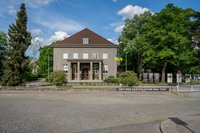Ein Torflügel eines Sperrzauns innerhalb des Standortes „Lychen II“. Lychen II, oder Das Sonderwaffenlager Himmelpfort, wurde 1967 als Lager für Atomsprengköpfe gebaut und unterstand direkt dem sowjetischen Generalstab in Moskau. Die Lager wurde 1990 aufgegeben.
Schon Im September 1958 begann am Standort Lychen (Fürstenberg) die Stationierung von sowjetischen Raketen in der DDR. Vier Jahre zuvor hatte die NATO damit auf westdeutschem Gebiet begonnen. Es folgte ein drei Jahrzehnte andauernder Rüstungswettlauf um Atomsprengköpfe und die Reichweite der Raketen. Vor allem ihre mobile und schnelle Einsatzfähigkeit entwickelte sich rasch weiter und veränderte die Kriegsplanung entscheidend.
en

